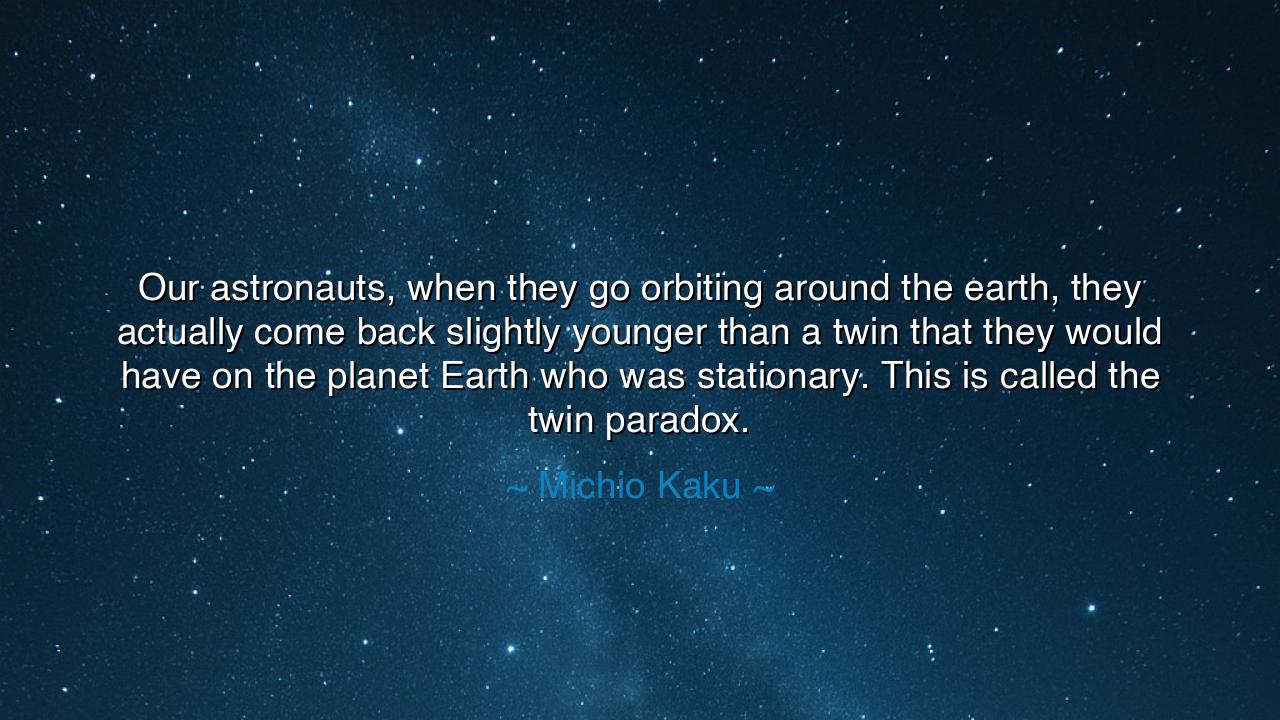
Our astronauts, when they go orbiting around the earth, they
Our astronauts, when they go orbiting around the earth, they actually come back slightly younger than a twin that they would have on the planet Earth who was stationary. This is called the twin paradox.






"Our astronauts, when they go orbiting around the Earth, they actually come back slightly younger than a twin that they would have on the planet Earth who was stationary. This is called the twin paradox." These words, spoken by the brilliant physicist Michio Kaku, encapsulate the incredible mystery and power of the universe itself. In this simple yet profound statement, Kaku introduces us to the twin paradox, a concept born from Einstein’s theory of relativity. The very notion that time is not a universal constant but something that can be altered by speed and gravity challenges the most basic understanding of reality. Time, it seems, is not something we can simply measure, but something that moves differently depending on where you are and how fast you're moving. This realization shakes the foundations of our perception of the universe and calls us to think more deeply about the fluidity and complexity of existence.
The ancients, too, were keen observers of the natural world, although their understanding of time was far different from our own. The Greeks, for instance, viewed time as cyclical, deeply connected to the cosmic rhythms of the stars and the seasons. Heraclitus, the great philosopher, famously said, "You cannot step into the same river twice," suggesting that all things are in constant flux. Yet, while the ancient philosophers recognized that change was an inescapable part of life, they did not yet know that time itself could bend, stretch, and warp under certain conditions. They saw time as linear and fixed, a part of the eternal order of things. But today, thanks to the works of Einstein, we know that time is far more mysterious and elastic than they could ever have imagined.
Kaku’s discussion of the twin paradox reveals a reality that is as mind-bending as it is beautiful. When an astronaut travels in space at high speeds, closer to the speed of light, their clock runs more slowly compared to someone who remains on Earth. Time—that constant we once thought we could rely on—begins to behave as a liquid, shifting and changing with velocity. The astronaut in orbit will return younger than their twin on Earth, despite having aged just as much as anyone would on a regular journey. The very fabric of reality is shown to be more fluid than we could have ever imagined, and the implications of this discovery stretch beyond science and into the realm of philosophy, where the nature of existence and time itself are called into question.
Consider the story of Einstein's theory of relativity, which revolutionized our understanding of space and time. Before Einstein, the accepted model of the universe was built on the work of Newton, who saw time and space as absolute, fixed entities. But when Einstein came onto the scene, he shattered this certainty with his theory of special relativity, proposing that time and space were interconnected and relative to the observer. Just as the twin paradox shows that time can move differently depending on speed, Einstein’s ideas revealed that the space-time continuum could be bent and stretched by mass and energy. The fabric of the universe, once thought to be immovable and unchangeable, is revealed to be something we can influence, something that is both mysterious and flexible.
This insight into the twin paradox forces us to confront a deeper truth: reality is far more complex than we ever imagined, and time is not the rigid, unstoppable force we once thought it to be. The very idea that an astronaut can return from space and age more slowly than their twin on Earth suggests that perception is everything—that what we see and experience is deeply shaped by our point of view. This revelation calls us to reconsider our approach to life and existence. It reminds us that we are not simply passive observers of a fixed world, but active participants in a dynamic, fluid universe. We must approach life with the understanding that everything is in motion, that every action and every choice has consequences far beyond what we can see in the moment.
The lesson here is one of openness and humility. The universe is vast and full of mysteries beyond our comprehension. Just as the ancients recognized the limits of their understanding, we must also embrace the truth that our knowledge, though vast, is still imperfect. The twin paradox teaches us that time—the very measure by which we live—can be transformed, bent, and shaped by forces beyond our control. In the same way, our lives are shaped by forces that we often do not understand or see. Yet, this is not a cause for despair, but a call to curiosity, to constantly question and explore the boundaries of our knowledge.
In your own life, let this lesson be a reminder that everything is in flux. Just as time can bend and warp under the influence of speed and gravity, so too can our lives be shaped by the forces of chance, decisions, and circumstance. Approach the world with a humble curiosity and an openness to the unknown, knowing that there are forces at play in the universe that are beyond our comprehension. Embrace the mystery of existence and recognize that even in the smallest moments, you are part of a much larger, interconnected reality. The future may hold even greater revelations, and just as the astronauts venture into the vast unknown of space, so too can you journey into the unknown corners of your own potential.






AAdministratorAdministrator
Welcome, honored guests. Please leave a comment, we will respond soon